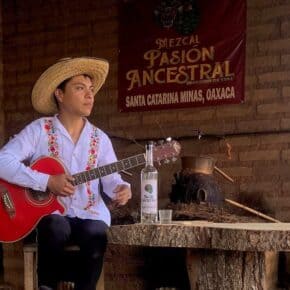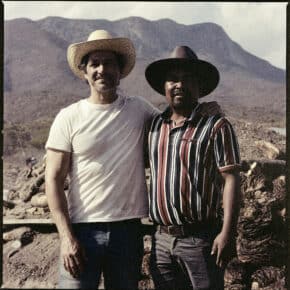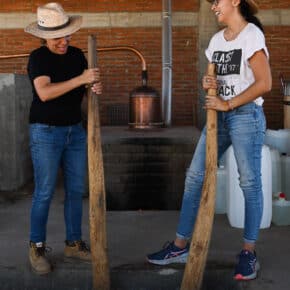This is a cross post from one of our frequent collaborators, Ferron Salniker. You can read her excellent blog Ferronlandia here. This piece was originally published on 4/9/16. You can read the original here. For those who don’t know, José Luis Diaz is an amazing chef who has come up with stunning combinations at pop ups and now, Chilhuacle Rojo, so definitely visit on your next trip to Oaxaca.
I met José Luis Diaz at his restaurant, Chilhuacle Rojo, in the Oaxaca centro. He has a deep voice, two chile pepper tattoos on his forearm, and uses yadadayadayada to finish out many of his sentences, but never— as I noticed during our breakfast tasting menu— when describing a dish.
Breakfast here was one of my best meals in Oaxaca. It was thoughtful with the pacing, our palates, and especially in the selection of ingredients.






Chilhuacle is a mildly hot, stout little chile endemic to Oaxaca and essential to traditional mole recipes, but these days it’s often omitted by cooks because of its high price point. Production has dwindled due to high growing costs, climate changes, and cheap out-of-state chiles coming in. There are only about five producers left. The restaurant name, the tattoos, the dried chiles hanging above the restaurant kitchen are testament to José Luis’s dedication to sourcing Oaxaca’s best ingredients and letting them shine. Produce for the restaurant comes from his family’s ranch which has been passed down his father’s side for generations.
So when he invited my friend Essence and I to come along with two German dudes to cook on the ranch the next day, we moved our plans.
Our first stop was the market in San Pedro Totolapam, which was actually just a line of open food stalls with maybe one vegetable stand. The mountains and clouds hovered in the background. Out came a strikingly beautiful plate of four enchiladas in a silky, coloradito (type of mole) and covered in queso fresco and bright leaves of parsley. Pretty much everyone in the car but me had been in a silent hangover fog during the hour drive (“that question is way too complicated right now,” said José Luis at one point in my gabbing). We started talking again over the enchiladas and slices of sour mangos.
On arrival to his parent’s house, his mom Lupe immediately pulled out tamarind pulp, candied mangos and guavas and set them on the baby-blue oil cloth-covered table. The tamarind tree hung over the patio and her outdoor kitchen. “Much cooler than cooking inside!” she said smiling while we fanned ourselves.
Afterwards, we stopped by the ranch to pick a few limes, which we bit into and threw in our beers while sitting in the shallow rio del valle.
Eventually, as José Luis expands his cooking classes, he’d like to bring more people to the ranch and San Pedro Totolapam, a beautiful town with a bright turquoise church, key lime trees, a river, and sadly intertwined— like so many places in Mexico— in the drug war.
At the ranch Lupe walked with us through the orchards. She found recently fallen mangos in the creek and picked a tiny green chile from a wild bush. The group then cut up fruits and veggies, marinated a pig, and covered it in banana leaves to let it steam over the fire. I drank some mezcal out of a sprite bottle and kept warm by the fire, unruly from the big scraggly branches. The nearly full moon came out lighting up the valley, and I asked Jose’s dad to tell us local ghost stories. He mostly just made dad jokes.
Two and something hours later, Lupe and José debated how much lime and salt to add to the broth reducing over the fire, and I helped crisp up some of the meat on the grill. Then we sat around the fire, sipping the broth and munching on tostadas sprinked with salt and lime (what would we do in Mexico without salt and lime?) Lupe served a purple agua made with tuna (cactus fruit). Before we left, we stopped by the house to have a poleo tea, which is a popular herb here for helping hangovers. It was minty and refreshing, and it was still warm enough in the kitchen for me to give Lupe back the jean jacket she lent me.
A few days later I took a cooking class with José Luis. By then I felt like I knew him a little bit. He has strong opinions, doesn’t hold them back, and definitely pushes boundaries, a good thing when it comes to food, maybe challenging in other arenas. For all the connection he feels to his hometown and where his ingredients come from, he tells me about numerous incidents where he’s isolated himself from much of the close-knit restaurant community in Oaxaca.
We walked to the Sánchez Pascuas market just above the city center to get a bunch of ingredients. It was the Friday before easter and half of the stands were closed, so he zipped around, teasing the fruit vendors in between making orders, while I sampled quesillo and bought some herbs for making tortillas. We agreed on making things that included ingredients I could easily find in the Bay Area like an almond mole instead of a few other chile-heavy options. (Although of course I smuggled some chilhuacles back).

In between getting an arm workout with the molcajete as I made green and red salsas, he showed me how to make amaranth horchata using water, lime peels, cinnamon and sugar. I learned from from José’s friend, Hope, that amaranth is endemic to Mexico and was a staple grain in pre-Colombian times. Hope works for Puente Mexico, a non-profit supporting amaranth production and consumption in Oaxaca. At Chilhuacle Rojo José Luis incorporates it into the menu, adding a nutritious and heartier twist to some desserts and drinks.
While I don’t think you can find chapulines at Berkeley Bowl (I mean, maybe, they do have like 15 apple varieties) I still wanted to make a grasshopper dressing. We sautéed them with garlic, oil, a little aioli and lime and blended them. Drizzle it over an omelet or some stuffed squash blossoms and I guarantee your bug-adverse friends will shut right up.
José’s teaching style is flexible, so when I complained that most of the tomatillo salsas I’ve had are too acidic for my taste, we added toasted pumpkin seeds to the molcajete rounding it out to something between a tomatillo salsa and sikil pak.
For dessert we made chocolate and guava sauces, adding local herbs like poleo and pitiona, and a local dried flower called rosita de cacao (yup, got them all in my suitcase too).
In total we made tortillas, stuffed squash blossoms, three salsas, almond mole, amaranth horchata, and dessert.
In the end the cooking class was one of my favorite days in Oaxaca, I think because I was engaged for hours with the senses and smells that most remind me of here: minty herbs, bright flowers, chiles, ashes, masa, chocolate. Good thing I’m bringing it all back.
Chilhuacle Rojo is open for breakfast starting at 9 a.m. Monday through Sunday. For $100 pesos you’ll receive coffee, tostadas and jam, a main breakfast, and chocolate. Please check the menu beforehand as it’s not your typical huevos a la mexicana place. Make reservations for private dinners or cooking classes via jld@chilhuaclerojo.com.mx. Address: Plaza Bugambilias, García Vigil 304.































Leave a Comment